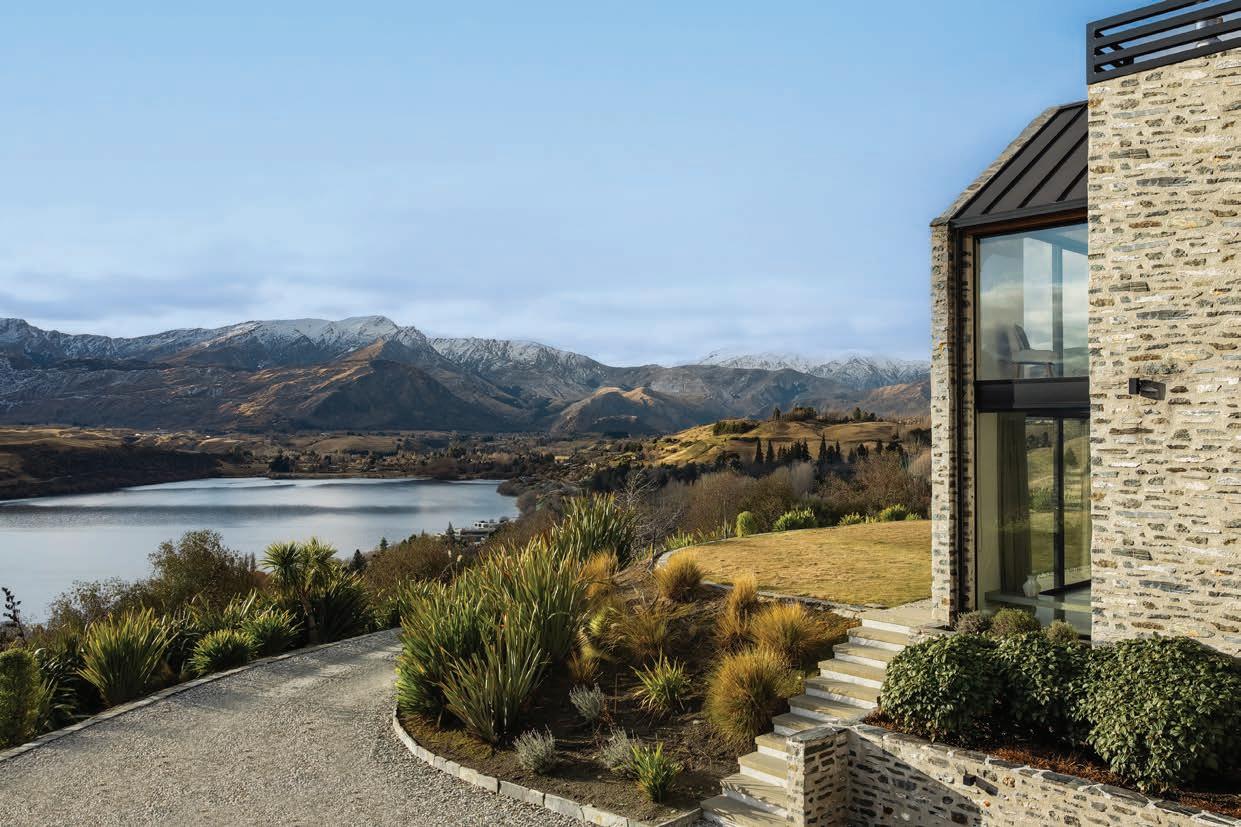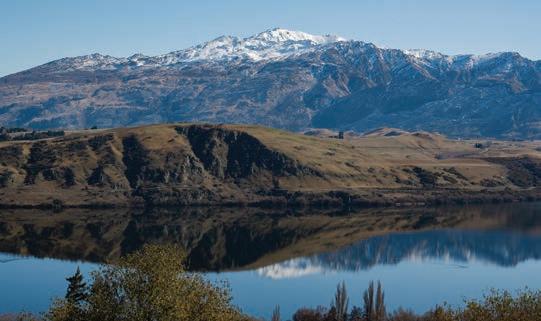

LAKES BUSINESS
SOUTHERN LAKES BUSINESS QUARTERLY


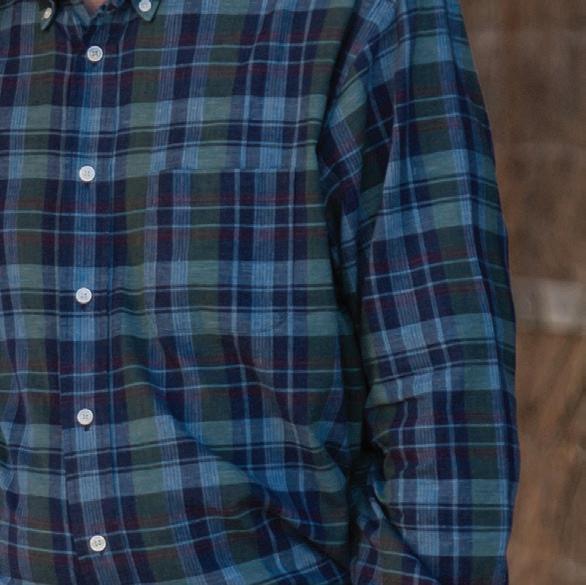






Debbi and Paul Brainerd The Headwaters Eco Lodge
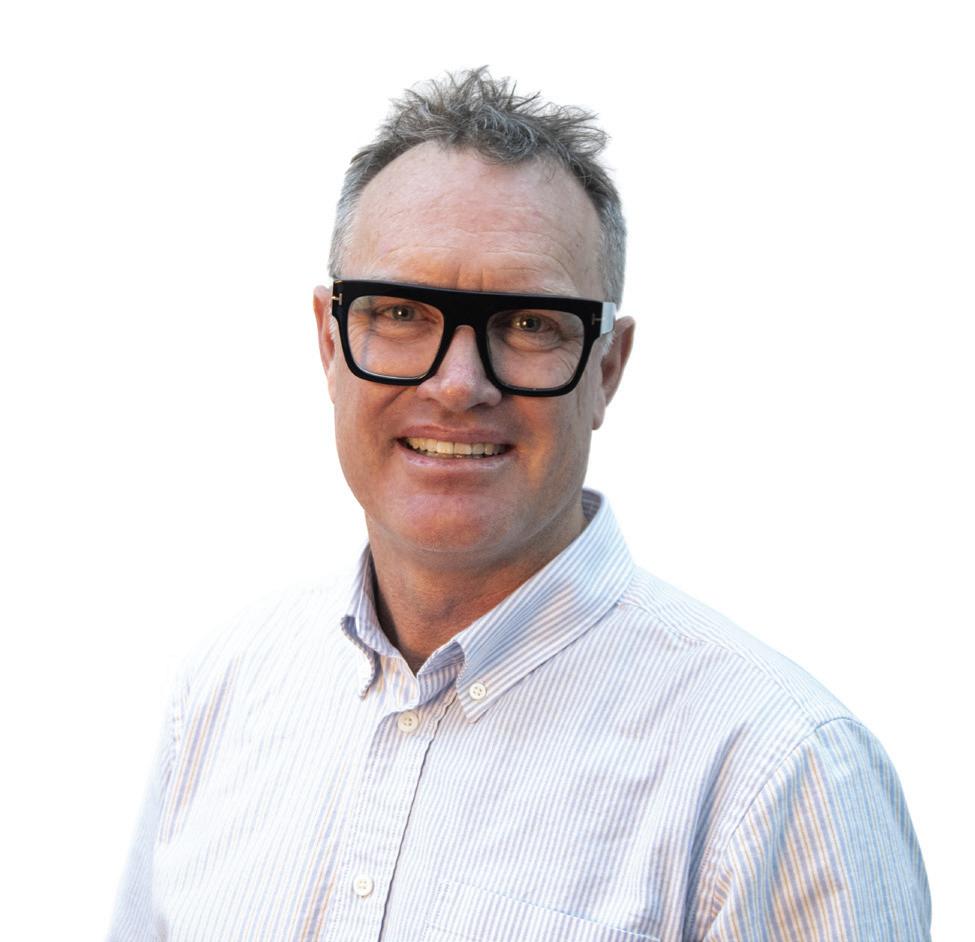
Sustainability.
noun the ability to be maintained at a certain rate or level.
In this sustainability issue of Southern Lakes Business, it’s inspiring see so many businesses embracing sustainability, ensuring Queenstown Lakes district is a thriving destination and a great place to live, now and in the future.
What comes to mind when you think about sustainability? By de nition, sustainability is the concept of maintaining, or supporting, something continuously over time. Generally, we associate this with environmental initiatives, which of course are crucial, but sustainability extends much further when we consider social and cultural wellbeing too.
At the heart of the Queenstown Lakes destination management plan (DMP) is a commitment to ensuring tourism contributes long term holistic value to our communities, the environment, and the economy. A collaboration between Destination Queenstown, Lake Wānaka Tourism and Queenstown Lakes District Council, the DMP outlines projects focused on ensuring this region remains a special place for generations to come.
One example is the ground-breaking project now underway to understand what optimal visitation in the Queenstown Lakes looks like. As a high growth region, with tourism at its heart, this project aims to build a model that will help guide better decisions and ensure the future of tourism is well planned, contributing to a thriving community, environment and industry.
As a business community, there are so many things we are all doing to preserve and protect the Queenstown Lakes, and these actions are critical to create a great future for the region. Embracing diversity, equity and inclusion in the workplace to create high performing teams; making products and experiences more accessible to exceed guest expectations; seeking renewable energy solutions like solar or hydrogen; buying locally; and investing in community initiatives that make a signi cant impact on people and place.
We are incredibly lucky to live in such a special part of the world and I’m constantly blown away by the amazing mahi happening to leave this place in better shape than we found it. From Michael Sly (‘Mr Chippy’) transforming tonnes of hotel food waste into compost, to Ngāi Tahu Tourism’s Shotover Jet on its way to becoming the world’s rst electric jet boat — the work being done from the ground up is what makes our region special.
If you’re keen to understand more about sustainability options for business or the destination management work underway, then I encourage you to contact DQ. We’d also like to hear about initiatives underway in your business to support the region’s regenerative future. It’s the small things, when done together at scale, that will make the greatest di erence.
Mat Woods Chief Executive Destination Queenstown
Kinloch
the
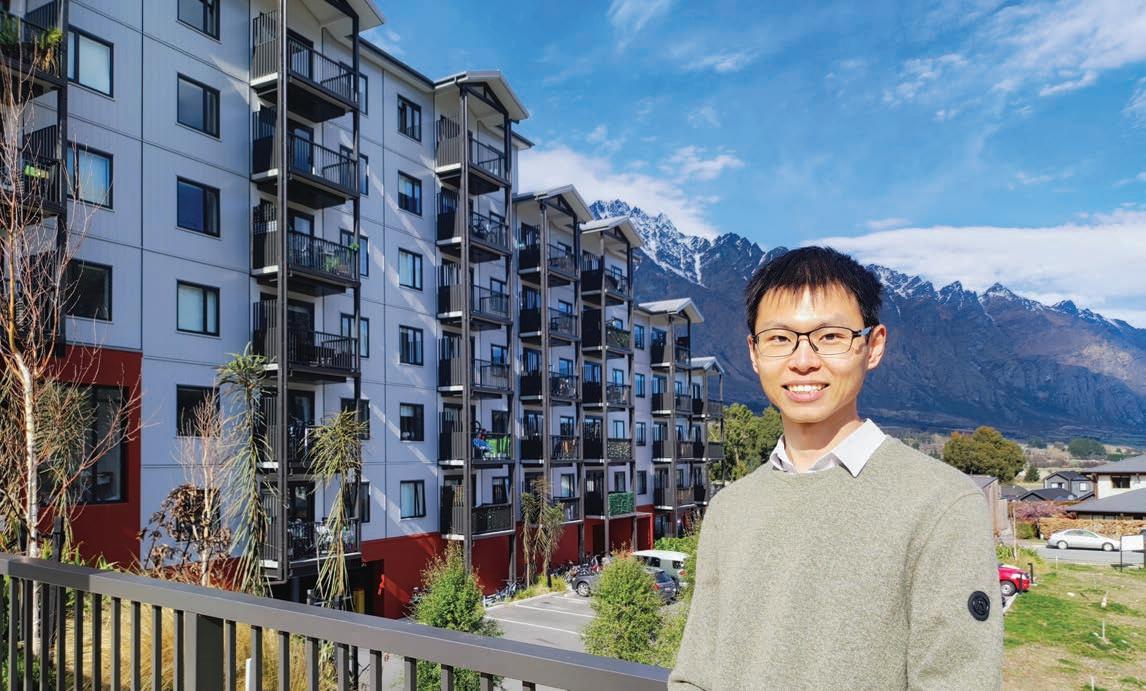
Affordable
ree words sum up Arthur Lee’s approach to making a ordable housing more sustainable and liveable. He wants to do things smarter, simpler and smaller. e Queenstown-based passive housing expert has recently been hired as Queenstown Lakes Community Housing Trust’s Sustainability and Development O cer. His goal is to ensure they are building warm, healthy, low-impact homes, that cost less to run, while continuing to get the most bang for their bucks on construction costs.
housing doesn’t have to cost the earth
by Paul Taylor
QLCHT chief executive Julie Scott says: “I always talk about the two aspects of housing a ordability - one is the actual cost to either buy or rent, and the other is the cost of running the home. Because if you’re paying $1000 a month for a power bill in winter, that’s a huge drain on a household budget.
“So, we started to build better performing homes, with mechanical ventilation, more insulation, things like that. We wanted to take it further but had done all we could internally and needed someone to come in and drive the next step change for us.”
MEET THE FAMILY LAW TEAM
Providing specialist advice on family matters: -Relationship Property, -Contracting Out/Prenuptial Agreements, -Separation, -Family Violence, -Protection Orders, -Care of Children, -Guardianship, -Dissolution of Marriage, -Oranga Tamariki Proceedings -PPPR Act Proceedings
Queenstown Office:
Level 2, Craigs Investment Partners House, 36 Grant Road, Queenstown
Wanaka Office:
Level 1, 78 Ardmore Street, Wanaka
Lee has lived in Queenstown for seven years, previously working for award-winning Queenstown practice Team Green Architects, on multi-million dollar homes, a er obtaining his Bachelor’s degree in architecture at the VIA University College in Denmark, a country with some of the best social housing in the world.
He’s settling into life at the non-pro t QLCHT, creating plans with Scott and Development Design Manager Trish Daley, aimed at creating step-by-step continuous improvement.
continued on p4


louise.denton@toddandwalker.com

Arthur Lee in front of QLCHT’s Toru Apartments, built by New Ground Capital
For projects already in the pipeline, that means reviewing and picking low-hanging fruit, relatively easy changes with decent outcomes. For planned projects further out, there’s the opportunity to make major gains, by collaborating early in the design and build process. And for the Trust’s future projects, the sky is the limit.
Low-hanging fruit
“A good example of low-hanging fruit is a fullyinsulated foundation,” he says.
“ e building code only requires partially-insulated foundations but in our climate, where the ground temperature is very low in winter, that doesn’t work. And the consequence is huge and very noticeable - you can have a concrete slab which is 13°C on one side, and 18°C on the other.
“By ensuring our design and build partners are fullyinsulating the foundations, which is just using another proprietary system nowadays, you’re talking maybe a 10% energy saving for the entire house for very little extra costs.”
Homestar for the win
Over at Longview in Hāwea, the Trust has recently completed 28 homes and has another 20 in the design phase, with 10 to follow later.
“Arthur has looked at the oor plans and believes with a few tweaks we could get these to Homestar 6 standard,” Scott says.
Homestar ratings run from 6 to 10, but even 6 is about 50% more energy e cient than a building code minimum house. e New Zealand Green Building Council has recently revised the Homestar scheme, to ensure certain elements relating to people’s health and comfort, and baseline energy e ciency, become the mandatory minimum.
“It is amazing in a way because it means anyone moving into a home with that rating has all those guarantees,” Lee says. “But it does make it harder to achieve in our district. If you achieve Homestar 6 here, that is already an admirable standard.
“Building just to code, that’s when you will come across a warm living room but a freezing bathroom,
LAKES
that kind of experience we don’t want for people. “It’s the long-term life cycle costs we’re trying to consider. If you look back at the old state housing, they always end up being almost impossible to heat and very hard to maintain.”
‘Cutting corners’ to save money
Lee says on future projects, good collaboration early on is a game-changer to strike the balance that drives economic, social and environmental sustainability. “ at’s where 20% of the e ort can generate 80% of the outcome,” he says. “Smarter design and simpler forms essentially drive usability, feasibility and simpler construction.
“You want a smart layout - that means a good functional, usable, liveable space that people will enjoy. And you want simpler building forms. Corners, for example, cost money in terms of construction, waste, increased heat loss, everything, so if we can design a building with six corners rather than 12, that’s a bene t. If we can use a simple gable roof, it’s cheaper than ve di erent planks of roof, all joining together.”
With a good design, going smaller doesn’t have to mean it’s a compromise, he says.
“You can build a four-bedroom house that’s 200sqm, with every room oversized for no reason, or we can do something that’s 130sqm but every space is well thought-out. ere’s still the storage and the viability, the layout and how people interact with the space, how people get the light of the sun, even in winter, all those things can be done on the drawing board.”
Other elements, such as the ground source heat pumps the Trust has included in its 68-unit project Tewa Banks in chilly Arrowtown, can also lower living costs, reducing power bills by 40-50%.
Doing more with less
Increasing density is also driver for the Trust.
Born in Auckland, Lee moved to Taiwan when he was six years old, living in what was one of the highest density neighbourhoods in the world - 200,000 people in the space of Frankton Arm - before returning to NZ. “It showed me it is possible to live in small spaces and still live a good life,” he says.
ree years ago, he was one of the Queenstowners helped out by QLCHT’s models, moving into the ‘high density’ Toru Apartments, although NZ’s high density is medium density in the rest of the world, he says.
Scott says with 1300 households on the waiting list, the Toru project is something the Trust would love to replicate.
“We’ve got 42 households in that building under a range of programs, which has been such a great outcome,” she says.
Prefab for the win
Innovative building practices are also in the Trust’s plans.
“I think realistically, o -site manufacturing has to be the way of the future for a ordable housing,” Scott says. “In NZ, we’re terrible for building lots of bespoke homes, whereas the Trust tries to work on standardisation and replication.
“You’ve got companies like Arbol in Cromwell at one end of the spectrum, quite small and bespoke, and then at the other end you can go to China and buy 50 apartments and stack them.
“We considered that for the Toru stage two apartments. Was that something we could bring in at a much reduced price? Because the land is still consented for another 140 units over two buildings. It’s potentially feasible and this is something Arthur’s looking into.”
And, it’s not only the building Lee is tasked with making more e cient. He’s looking at all QLCHT operations, as it looks to reduce its carbon footprint. “Although, in a single house’s life cycle, carbon emissions can be 150-200tn, compared to our yearly operational emissions of probably 2-4tn,” he says, “so the development side will be our main focus.”
Overall, he sees his new role at QLCHT as a way to make a di erence. “It’s ful lling and a passion rooted in me since university, when we were required to study social housing and practice design and construction management models on social housing.”

QLCHT’s Tewa Banks project is under construction. The project was given a sustainability review last year, at the resource consent stage, resulting in the addition of ground source heat pump systems across the development
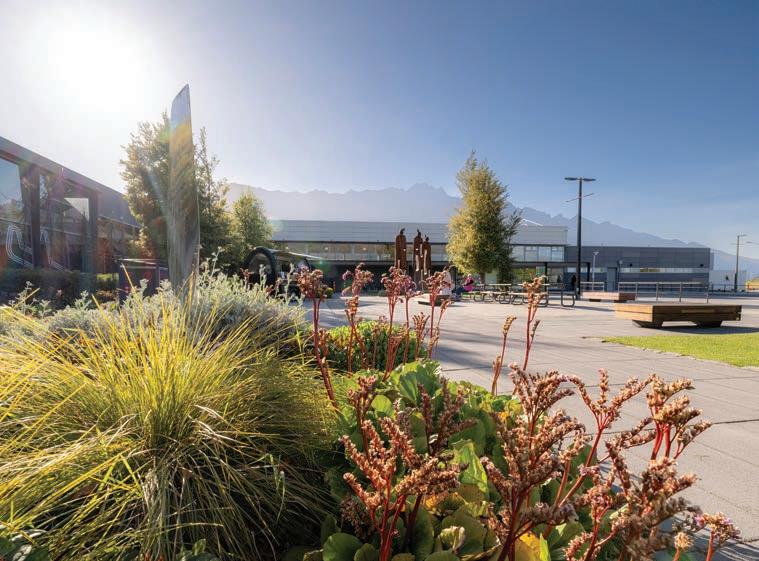
On a mission to make ZQN more sustainable
Wayne Stiven is a man with many responsibilities. As Queenstown Airport’s Head of Assets and the Airport Emergency Service, he leads a team looking a er everything from the runway to the rubbish.
It’s a job he relishes, enjoying both the variety of the work and the camaraderie among the members of his team. However, he acknowledges working at an airport does not suit everyone.
“ e dynamic nature of aviation means you have to be able to adapt quickly to changing situations and, underpinning that, you have to be well prepared and highly organised.”
Stiven brought a wealth of experience in information technology, systems development, and project management with him when he joined the Queenstown Airport team in 2016. His initial title was Technology Manager but over time the scope of his role has expanded considerably.
“Airport infrastructure is complex, so we have to be multi-taskers, and we get to work on a range of really interesting projects.”
e latest is the installation of an engineered materials arresting system (EMAS), which is designed to safely bring an aircra to a controlled stop with little damage, should one overshoot the main runway. ere’s never been such an incident at Queenstown, but the airport wants to reduce the risk if an overrun did occur.
“We are proud to be the rst airport in New Zealand or Australia to invest in this technology, which has been well proven in the northern hemisphere,” Stiven says. “It exceeds what we are required to do under civil aviation regulations and it’s proof we take safety very seriously.”
e project has a price tag of more than $20 million. Preliminary work is just getting under way and the project should be nished by late summer.
Another thing Queenstown Airport takes seriously is its Sustainability Strategy.
“It guides all our decisions and how we do business,” Stiven says.
As maintenance is scheduled and facilities are upgraded, he and his team look for opportunities to reduce greenhouse gas emissions, introduce more sustainable practices, and support this region’s biodiversity.
Recently, six chargers were installed to enable airlines to use electric ground service equipment to position, load, and unload aircra at Queenstown Airport.
“To make that possible, we had to increase the capacity of one of the airport’s two electrical transformers.”
e airport also provides free charging for electric vehicles in its car parks, although standard parking fees apply, and it has an electric car for sta to use when travelling around the region.
“We’ll add more electric vehicles to our eet as soon as suitable models are available,” Stiven says.
Another important project is an upgrade of the system used to ventilate and control the temperature in the airport terminal. Some of the parts are 25 years old.
“We have a dry, low-corrosion environment,” Stiven says. “ at means components last much longer than usual here, which is good from a cost perspective, but a diesel boiler is used to preheat the system.
Decommissioning that is an essential part of our decarbonisation programme, so as we upgrade each section, we are clipping it o and transferring it to electric preheating.”
is work is scheduled for completion over the next 12 months, then the boiler will be switched o permanently.
E cient use of energy is a key focus of the terminal upgrade programme, with LED lighting tted throughout the building and sophisticated sensor technology used to switch it o when it is not needed.
“It’s a dual thing: it reduces energy usage and it saves us money.”
Stiven says Queenstown Airport is successfully using technology to drive innovation, e ciency, and optimisation.
A good example is the self-service check-in kiosks and automated bag drops, which have signi cantly sped up passenger processing and reduced queues.
“ at greatly improves the customer experience.” However, reducing waste is proving to be a tougher challenge.
e assets and facilities team works hard to nd new uses for materials.
Carpet tiles removed from the terminal have been given away and laid in garages, sheds, and kennels across the Whakatipu Basin.
Asphalt millings produced during runway maintenance are used to form paths and car parks.
Food scraps and other organic waste is composted on site. e compost is then used to nourish the airport’s gardens, which showcase native plants and create a distinctive sense of place for people arriving in Queenstown.
Getting people to separate recyclable materials into the correct bins is di cult and high contamination rates mean some ends up in land ll. As a solution, a sorting programme is being established.
“It’s unfortunate that is necessary, but we are committed to doing everything we can to protect the environment, and if that means rummaging through the rubbish, then that’s what we’ll do,” he says. at ‘can-do’ attitude is making a positive di erence for both the business and the planet.

Queenstown Airport’s Head of Assets and the Airport Emergency Service Wayne Stiven
Queenstown Airport’s much-admired gardens
LAKES

The Headwaters Eco Lodge leads the way in sustainability
e Headwaters Eco Lodge is a business ahead of its time, leading the way in sustainability by operating to world-class regenerative design principles since it opened in 2018.
It all started when American philanthropists Paul and Debbi Brainerd fell in love with Glenorchy more than 20 years ago and one day spotted a ‘For Sale’ sign on the former Glenorchy Camping Ground.
eir vision from the outset was to create a thriving and regenerative business model that was environmentally and nancially sustainable, giving back to its local community and the wider world. And its achievements in the six years it’s been open are impressive, including recently being named a nalist in the New Zealand Tourism Awards in the environment category.
e Headwaters Eco Lodge is the rst-ever accommodation facility designed and certi ed to Living Building Challenge (LBC) standards, the world’s most rigorous and comprehensive sustainability guidelines. It’s certi ed by the International Living Future Institute for its inspiring and regenerative approach to energy, water, materials and beauty.

Its passive design and state-of-the-art technology reduce water and energy consumption to 50% less than similar accommodation businesses. Water optimisation is achieved through an innovative closed loop water system, plus timed showers and compostable toilets saving 400,000 litres of water a year.
e lodge generates its own energy onsite thanks to one of the South Island’s largest solar gardens (589 solar photovoltaic panels spread around the property) and ground source heating throughout to achieve Net Positive Energy certi cation. at energy fuels its state-of-the-art buildings including the impressive main lodge plus14 eco-chalets for guests. ere’s enough le over to comfortably power nearby Mrs Woolly’s General Store and its busy café, gi store and art gallery.
Celebrating nature
e Scheelite Shelter is a covered outdoor space that’s perfect for gathering around a roaring re, pinot noir in hand, surrounded by three constructed wetlands with native plantings that process greywater from sinks, showers and washing machines. e hundreds of native plants support local biodiversity through pollination levels and seed dispersion.
Every detail has been thought through to deliver an invigorating blend of hospitality, beauty, sustainability, restorative experiences and educational opportunities, a new type of guest experience for New Zealand’s visitor accommodation sector.
e Living Building Challenge uses a ower metaphor to re ect a healthy living entity. e building is rooted in place and generates its own fuel, collecting its own water, supporting its local ecosystem and community (via pollination), and becoming food for the local ecosystem at the end of its life. Vital aspects (petals) of the ower are woven throughout the guest experience.
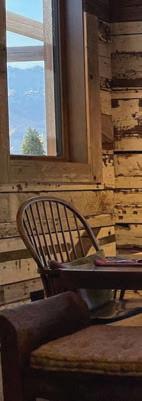
SOUTHERN LAKES BUSINESS
Community bene ts
Community input, interests and concerns formed the foundation of the lodge design. Over two years’ consultation and 400 community conversations throughout the design and build process helped understand needs of neighbours, locals and visitors.
In contrast to a typical building project which blends a team of architects, designers, and engineers, e Headwaters Eco Lodge approach also included artists, cra speople and energy management specialists.
Nearly 100 Glenorchy residents took part in its creation by providing labour, cra smanship, business services or as volunteers, and it now employs around 25 locals.
All pro ts from operations are donated to the locally-administered Glenorchy Community Trust to help increase the vibrancy and resilience of the community. Within the past year, the Headwaters commissioned New Zealand’s rst community composting facility in partnership with the Queenstown Lakes District Council, which has diverted about 26 tonnes of organic waste from land ll so far. ere’s now a kerbside waste collection by e-bike, and compost is donated to the local Glenorchy community nursery, and also back to commercial and residential users who donate waste.
oughtful food and Christmas menus
e Lodge mitigates its food miles with its Chef’s Choice menu in e Dining Room focusing on local, seasonal produce grown in its kitchen garden and solar greenhouse.
Already hugely popular with guests and locals, renowned Executive Chef Pete Gawron (formerly of Arrowtown’s hugely popular Sa ron restaurant) helms the kitchen team, proudly showcasing freshly-prepared garden-to-table each day with ‘just picked’ produce from the gardens and beautiful ingredients from Central Otago providers.
Local businesses with sustainability at the forefront of their sta celebrations can choose to enjoy a delicious two-course Christmas lunch with a menu designed by Chef Pete, or Scheelite Grazing Plates served in front of the roaring re in the Scheelite Shelter (both are minimum groups of 10 with bookings required). ose who like some adventure thrown in with their sta functions might consider the Paradise Adventure package which includes ziplining with Paradise Ziplines and a three-course Chef’s Choice Dinner. For smaller groups a Cooking Class including lunch might tempt the tastebuds.
Bookings at events@theheadwatersecolodge.co.nz


G.J. Gardner Homes setting new standards
Sponsored
Five tonnes of GIB board, at least a couple of tonnes of metal, 400kgs of cardboard, and as much le over plastic as possible.
at’s what G.J. Gardner Homes Queenstown Lakes centralised Hanley Farm recycling depot is diverting from land ll each month.
e local franchise of New Zealand’s most-trusted house building company struck on the smart idea of using one vacant section as a place to gather all recyclables while working in the subdivision, where it has up to 40 homes under construction at any one time.
Following the success of this, GJ Gardner have set up a similar recycling site for their builds in Wānaka and Hāwea.
And GJ’s Queenstown Lakes GM Stephen Hardy says it’s almost cost-neutral because the metal can be sold on.
“ e younger generation coming through are now really, really passionate about sustainability, it’s very important to them as it is to us,” he says.
“So this project is client-driven, but what has blown me away is the appreciation from the trades as well, for the steps we’ve been taking. I’ve actually got emails of thanks from some tradies, particularly electricians, who said they were gutted to be throwing away the cardboards and plastics, and had previously tried to recycle them but it proved too challenging logistically.”
Hardy says recycling on a section-by-section basis is hard, because there’s not much space for the di erent bins and tradies need to add in trips to the recycling depot. It can even be a challenge to get a skip on some of the sites.
e company already reused some elements, like all its plastic wraps, but has been working with All Waste to ensure as much of its construction waste is recycled as it can.
“For the GIB board, it’s the o cuts but an astronomical amount really, ve tonnes per month on average and some months up to eight tonnes. It can be turned back into landscaping products. e cardboard is around 400kgs per month and the metal uctuates.”
e communal depot has worked so well, Queenstown Lakes District Council has taken an interest in using it as a case study, while Hardy’s also had discussions with Wānaka’s Better Building Working Group, formed from the 2018 Wao Summit. e group has 40 members, including GJs.
“It’s something we contribute a lot of volunteer time toward for the greater good. It’s about sharing the knowledge for better standards,” Hardy says. “I de nitely think we’re leading the way and setting a new standard in Queenstown. But for us, it’s a bit of future-proo ng, because I’d anticipate down the track, either through the building code or consenting through council, this level of recycling will become mandatory.”
G.J. Gardner Homes is also looking to tackle the problem earlier in the supply chain, o ering customers the option to build more sustainable homes.
“We’ve been working with suppliers on a local and national level to identify sustainable products and next month [October] we’re rolling out a sustainable speci cation for our clients, that they can choose as standard for their build.
“It will include wool insulation, wool carpets, recycled underlays, plant-based paints, renewable timber claddings, that sort of thing.”
With construction, the company already uses 140mm framing as standard, allowing for better insultation, which in turn means using less energy to heat the house. It also o ers energy e cient windows and on a national level partners with Harrison Solar.
“We o er some really good deals with national buying power for our clients there, and with advancements in battery technology, we’re seeing more and more clients request solar. ere are also some good deals out there from the energy companies for discounted or free energy in the evenings for households with solar, with the o set being that the feed into the grid in the daytime, so that’s making it more popular.”
For more information about G.J. Gardner Homes Queenstown visit www.gjgardner.co.nz or ph. 0800 42 45 46

Wao Summit 2024: Harnessing the power of business
Love it or hate it, business has power. And though the force of commerce has historically been associated more with exploitation than regeneration, the tides are changing and bringing new ideas to shore. In fact, B Corp consultant Tim Jones thinks business is the most powerful tool for creating the kind of long term positive change we need.
“Individuals are typically too small to make a big di erence,” says Jones, who will be running a B Corp workshop at the 2024 Wao Better Business Day. “And, as we’ve seen in the US and even here in New Zealand, it’s not uncommon that government decisions are made based on business decisions behind closed doors.”
e B Corp (or Better Corporation) movement suggests that business could be done a whole lot better - that it could be a force for good, and, quite possibly, it could save us in our mission to create a thriving and socially just future.
By de nition, Certi ed B Corps are businesses that seek to balance purpose and pro t and are willing to be held accountable for this. e rise in the number of B Corps is a testament to the credibility of this framework, with 422 certi ed companies in New Zealand including local businesses like Greenhawk, ahha, MONS Royale, Lake Hawea Station and Felton Road. Jones’ workshop is about demystifying the certi cation process for local Southern Lakes business owners.
With ideas like these in the foreground, the Wao Summit programme for 2024 has been designed with a major focus on local business. As non-pro t Wao Aotearoa director Monique Kelly says, they have enormous potential to amplify community action - the action which has been at the heart of the Wao Summit since it began seven years ago.
“Business owners are also usually locals who are concerned about the future of this community,” Kelly says. “ ey’re in touch with the reality of what’s
happening and are eager to integrate this into their business.”
e Wao Better Business Day will be held on Wednesday, 30 October, in Wānaka. Alongside a stacked line up, Jones, who runs B Corp consultancy business Grow Good, will be leading a workshop called Go B Corp For Good. As well as explaining the certi cation process, the kaupapa of the session is to explain how to leverage the framework for better business practices.
Jones says one of the biggest challenges faced by those considering the B Corp journey is people not thinking they’re good enough. “A lot don’t even attempt to do B Corp because they just go, ‘Well, we won’t be as good as Patagonia or some other company that is doing some pretty cool stu .’ So there’s a lot of imposter syndrome.”
Most, he says, are underestimating and underselling themselves. We are, a er all, usually capable of much more than we believe. e other most common challenge is the lack of time and the perception of a lack of resources, though Jones says that for smaller businesses, the cost of change is usually low. For larger companies with big systems to overhaul, there are certainly bigger upfront costs involved.
e desire to do good by people and the planet is not rare, but in business, it can lose out pretty quickly to the bottom line. But according to Jones, recent insight reports show B Corps have been outperforming ordinary business in terms of top line growth. He says the evidence is overwhelming that making these changes is also good for business.
As Kelly says, businesses are under increasing pressure to change the way they operate in order to get nancing. “So the Better Business Day is an opportunity for them to upskill, and to have the support to do this.” Kelly will be running a workshop called How to Shi a System, which will take us through the nuts and bolts of how
to drive transformative change through a systems lens. With a challenge as vast as climate action, it can be overwhelming to know where to start. is is what climate change consultant and principal consultant at Environmental Accounting Services, Dr Carly Green, will be o ering guidance on in the session Mastering Climate Action Priorities. Whether your business or organisation is just starting out on its emissions journey or you’re looking to level up your e orts, this class will help you prioritise action.
Of course, we can’t talk about the future of business without thoroughly examining it through a tech lens. In the Cybersecurity in the Green Economy session, cybersecurity expert Nick Baty will talk about transitioning to a carbon-zero yet digitally insecure world, and how to manage cyber threats for a safer future.
“I don’t think we can overstate the importance of this,” Kelly says. “I’m most looking forward to gaining a better understanding of how AI and technology are going to impact and in uence the coming decades.”
To nish o the day, the Let’s Do Better Business panel will bring Dr Carly Green, Tim Jones, Nick Baty and Alec Tang (climate advocate at KPMG and member of the Climate Reference Group) together for a future proo ng korero at Wilson & Dorset.
e world of commerce is a powerful one, and this has o en been fraught with negative connotations. But what if we can harness this power, and use it where it’s needed most?
e 2024 Wao Summit Better Business Day will be a rich and juicy exploration of all that is possible in this space. Tickets can be bought for individual workshops, but priority will be given to full day pass holders. Trust us, this is a day worth skipping the o ce for.
Full programme and tickets available from wao.co.nz





Protecting the environment at the heart of our home
Love Queenstown is a giving platform that invites our visitors and visitor industry to support the protection and regeneration of the environment at the heart of our home. Established in 2023 as part of the region’s destination management plan, Love Queenstown raises funds and awareness for local environmental action. In its rst 12 months, Love Queenstown – together with partner-initiative Love Wānaka – raised over $80,000 to support grass roots environmental e orts, planted over four and a half thousand native trees with hundreds of industry volunteers, and connected numerous visitors to local volunteer opportunities. Now, Love Queenstown is expanding its partnership opportunities – opening the initiative up to the wider business community and providing the opportunity for businesses big and small to make a di erence to the environment we love.
Love Queenstown Impact Grant recipients 2024
In July, three local organisations received grants totalling more than $25,000 in the inaugural Love Queenstown funding round. In addition to Love Queenstown’s Annual Impact Grants, 20% of all funds raised are invested in an endowment fund with support from Love Queenstown’s charitable partner, the Wakatipu Community Foundation. is fund will grow over time, enabling long-term funding opportunities into the future.
Whakatipu Reforestation Trust, Slope Hill Restoration
e Whakatipu Reforestation Trust (WRT) is on a mission to restore native biodiversity in the Whakatipu Basin through native revegetation, education, and advocacy. With 90% of native vegetation already lost in the Queenstown Lakes, the Reforestation Trust aims to empower the community to regenerate this one-ofa-kind environment.
e project funding from Love Queenstown will support the Trust’s ongoing restoration e orts at Slope Hill where tens of thousands of trees are to be planted this Spring.
Tāhuna Glenorchy Dark Skies Group, Rees Valley Conservation
e Tāhuna-Glenorchy Dark Skies Group will soon receive its designation as an International Dark Sky Sanctuary – one of only 21 in the world. e Group’s mission is to preserve the Dark Skies and to care for the biodiversity within the Sanctuary. is funding kickstarts the Group’s conservation e orts, with a project based on acoustic data-monitoring to identify native short-tailed bat habitats in the Rees Valley. Targeted conservation e orts will then ensure this taonga (treasured) species can thrive in its environment.




Whakatipu Wildlife Trust, Pest Eradication
e Whakatipu Wildlife Trust drives predator control e orts throughout the Queenstown Lakes, representing an important and uni ed voice for wildlife in the Whakatipu Basin. With over 35 critically endangered species throughout this area, their work is vital for the protection of our region’s biodiversity. e funding from Love Queenstown will further support the Trust’s e orts to create and maintain a predator-free environment in the Whakatipu Basin, enabling native wildlife to ourish.
Love Queenstown is an initiative of Destination Queenstown and is delivered in partnership with the Wakatipu Community Foundation
Love Queenstown Coordinator Ash Bickley with Destination Queenstown’s CE, Mat Woods
SOUTHERN LAKES BUSINESS
Love Queenstown Partners
Love Queenstown provides the opportunity for our industry to come together and leave a legacy we can be proud of. Here’s how three local businesses are joining the mission.
Skyline Queenstown
As a proud member of Love Queenstown’s Impact Partner Programme, Skyline has committed to an annual funding partnership and receives an additional accolade as a member of the “Founding 50” – recognition of the rst 50 businesses to support Love Queenstown in this way.
“Skyline Queenstown is incredibly proud to be among the Founding 50 of the Love Queenstown Impact Partner Programme. is initiative provides a great opportunity for local businesses to accelerate the positive impact we can all have on the Queenstown Lakes environment. We look forward to seeing the real and tangible bene ts our collective e orts will bring to the region”. (Wayne Rose, GM Skyline Queenstown).
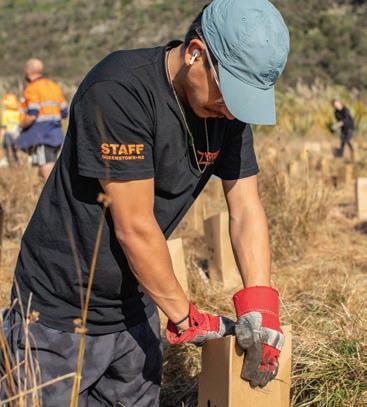
Ziptrek Ecotours

Ziptrek partnered with Love Queenstown for their most recent local’s day, with half of all ticket sales donated to Love Queenstown. “We were thrilled to have partnered with Love Queenstown for this event, raising over $4,000 to support the protection and regeneration of our environment. is initiative underscores our commitment to sustainability and conservation in Queenstown-Lakes, ensuring we contribute positively to our community and natural surroundings. Our local’s days provide the opportunity to share our special part of the world with those who live here, and this one was extra special as it provided the opportunity to give back to the very environment that makes it all possible” (Trent Yeo, Ziptrek Exec Director).
Ri ers Gin
Ri ers is a small boutique distillery making a big impact. With sustainability at the heart of every bottle, Ri ers forages for botanicals locally using only the freshest ingredients for its gin and vodka varieties. Now, the team at Ri ers is giving back through the recently released Ri ers Arrowtown Vodka, with every bottle sold supporting climate, conservation and biodiversity projects in the region.
“Inspired by the thyme-scented breezes of the region and pristine glacial waters, we’re proud to say each bottle of Arrowtown Vodka will give back to the land with a portion of sales supporting the Love Queenstown Community Fund.” (Philip Riley, Ri ers General Manager)
How to join the mission
Building a strong purpose into your business – and backing it up with tangible action – is more important now than ever. But it’s not only a win for the environment, it’s a win for your business, too.
Every dollar Love Queenstown raises is pooled for collective impact, so no matter the size of your business or your contribution, your support drives meaningful mahi (work) that will make a real di erence to this place, now and into the future.
Here’s how your business can support Love Queenstown:
Become an Impact Partner
Sign up to Love Queenstown’s newly-launched Impact Partner Programme, committing 1% of your business’ annual proceeds (or a total of $10,000 or more) to support local environmental e orts. It’s simple, convenient, and most importantly, impactful.
Be among the rst of Love Queenstown’s Impact Partners and receive additional recognition as a member of the Founding 50, solidifying your reputation as a business that goes above and beyond for our environment.
Donate to Love Queenstown
Become a monthly donor or make a charitable donation as and when you can. Every dollar raised goes towards protecting and regenerating Queenstown’s environment. Love Queenstown’s grants are allocated exclusively within this region, giving life to the organisations and initiatives who know this place best.
All donations are eligible for charitable tax bene t and will support the collective e ort to protect this special place.
Spread the word
Display Love Queenstown assets or donation cards in store or use your online presence to connect your customers with opportunities to donate or lend a hand. It’s the telling of a new story about how to visit Queenstown and inspires the type of travel that we hope to see going forward.
Reach out to the team to request your Love Queenstown asset pack.
Invite your guests to contribute
Make the rst move by adding a donation onto the cost of your product or experience, suggest a voluntary donation at the point of sale, or encourage donations in lieu of tips or booking bonuses.
Scan here for more information:





Wao
Summit
e link between a Kiwisaver fund and the future of energy e cient housing isn’t an immediately obvious one. But for Sam Stubbs, speaker at the 2024 Wao Summit Better Building Day and founder of low-fee fund Simplicity, it presented a clear opportunity.
e Simplicity Homes and Income Fund o ers a model of e ciency, building high density apartmentsto-rent at scale to reduce costs and waste. “ e way we do it is by controlling the entire process, so we get rid of what I call the lo pastry of fees that come from doing it bespoke and small scale,” says Stubbs, who is known for speaking out against the nance sector and its high, extractive fees.
Stubbs explains that the Simplicity homes are energy e cient, but not just by merit of being smaller and cheaper to build. “We build out of concrete, brick, steel, aluminium and glass. It doesn’t sound very glamorous, but they have a very high thermal e ciency. ey’re very warm, and very dry. We build in about half the time and use about half the labour of a normal place, which means that we have about 20% of the waste material of a typical build.”
Most Kiwis are not quick to get excited about high density housing. As Stubbs points out, with a historic abundance of land, Aotearoa is the last cab o the ranks where this is concerned. However, our population is growing and Stubbs does o er one new model of thinking, and a solution to having too many big, ine cient homes. And as Wao director Monique Kelly points out, we are in great need of some new models. “Right now we are not making climate safe, healthy or a ordable homes. Our building standards are not t for purpose and well below those of other OECD countries,” Kelly says. “ ere is a focus in the industry on the upfront cost of building a house, reducing this down to a per-square-metre rate which is only a small part of the whole picture.”
e real focus, Kelly says, needs to be on the value of the house over its entire lifetime. at is, how does it perform, how long does it last for and what are its operating costs over that time?
2024: How do we build better?
In a rapidly growing region like the Southern Lakes, these issues are front of mind. Kath Buttar, Senior Sustainability Advisor at QLDC, is another speaker on the programme at the Better Building Day. As part of e Current Playing Field session, she will delve into the big picture side of construction waste.
“In the Queenstown Lakes District, construction and demolition waste accounts for a staggering 32% of all waste generated,” Buttar says. “ at translates to around 242 tonnes landing in land ll every week. is poses a signi cant environmental challenge by lling up Victoria Flats, creating emissions and wasting nite resources. But it also presents an opportunity for innovation and leadership.”
ough the challenges are enormous, Buttar is looking forward to bringing some optimism to the session. “We have encountered some incredible examples of sustainable building practices right here in our district, showcasing that change is not only possible but already happening.”
To that end, Buttar will be pro ling some of the more inspiring things going on in our community, emphasising that it’s not a pipe dream, and everyone’s got a part to play.
Stubbs and Buttar are just two voices from the diverse lineup of speakers and facilitators across the Wao Summit Better Building Days. e rst, a longer day with more sessions, will be held in Luggate on ursday, 31 October. e second will be held in Queenstown on Friday, 1 November. Details on both can be found at wao.co.nz.
Alongside scale and e ciency there will, of course, be a big focus on design. is is something speaker Arthur Lee is particularly passionate about. Lee is a Passive House Designer and, currently, Sustainability & Development O cer at Queenstown Lakes Community Housing Trust.
Lee is one of the facilitators of the Better Building Day’s NZ Green Building Council Homestar Masterclass, which will provide insight into the core logic of the Homestar framework. e session will also o er
practical instruction on how to maximise the bene ts in the Homestar V5 Design Guide - a practical design guide to lower carbon healthier homes, which Lee coauthored.
Lee sees himself as a guardian for building performance, and doesn’t necessarily think the tension between a ordability and energy e ciency is a negative thing. “It will always be there,” he says. “Traditionally, cheap and big houses were the Kiwi dream. is model o en comes with high operational cost (energy and maintenance), high social cost (cold and mouldy) and high environmental cost (intensive energy use and embodied carbon).”
Lee thinks that a high cost of construction may not be a bad thing for lower carbon, better quality housing. “It forces people to make buildings smarter, simpler, and smaller,” he explains. “Intentional or not, this o en means better quality, occupant wellbeing, energy e ciency and lower carbon.”
Perhaps then, contrary to the common rhetoric, it doesn’t need to cost more to build a more energy e cient home - if we’re able to go small. And this is exactly what the Better Building Days are for; to come together as an industry and discuss solutions, leaving no stone unturned.
Other sessions include Building for the Future, Integrated Design and Materials Circularity, and Carbon Counting. ere will be one exploring tools for On-Site Management, and another on Biophilic Design and not building ‘toxic boxes’.
e Better Building Days are for builders, architects and anyone interested in the building ecosystemwith the option to get points towards LBP or NZIA certi cations. ere will be speaker sessions, breakout workshops and plenty of time to discuss and re ect. Luggate and Wānaka will host a full day event including lunch and morning talks. Queenstown will be a repeat of all a ernoon workshops and masterclasses - and a perfect opportunity if you missed an overlapping session over the hill . We can’t wait to see you there. Full programme and tickets available from wao.co.nz

Kinloch Wilderness Retreat: A sanctuary for locals after 24 years of sustainable growth
At Kinloch Wilderness Retreat, sustainability is woven into everything we do, guided by our core values: Intelligence, oughtfulness, Environment, Community, and Fun. ese values have shaped our decisions over the past 24 years, driving us to continually improve and grow Kinloch with a focus on sustainable development. We’re inviting locals to experience this unique blend of sustainability and comfort. Located just an hour from Queenstown, Kinloch o ers the perfect escape where you can disconnect from daily life and reconnect with nature.
A journey of sustainable innovation
Our sustainability journey took a major leap in 2016 with the purchase of our rst petrol hybrid vehicle. is set the stage for bigger changes, including the 2017 construction of our passive-style EcoScapes using SIP (Structural Insulated Panels). ese o -grid rooms combine energy e ciency with modern design, o ering stunning views while being powered by solar energy.
Since then, we’ve electri ed almost everything on the property - from garden tools and lawn mowers to the addition of three more electric vehicles. Solar panels and power walls now adorn all our buildings, ensuring we generate and store renewable energy.
Our sustainability e orts have earned us a Gold Sustainability rating from Qualmark, and we are on the path to B Corp certi cation, re ecting our commitment to balancing purpose with pro t.
e best of heritage and modern design
In addition to our EcoScapes, we’ve redeveloped the old Heritage Lodge to meet 70% NBS (New Building Standard), preserving and enhancing its Heritage-listed character. e Heritage Lodge has become a wonderful homestead for groups and families to enjoy, blending its timeless charm with modern comfort. Now, guests can choose between the state-of-the-art EcoScapes for a cosy couple’s retreat or the

warmth of the Heritage Lodge for larger groups - a perfect mix of old and new and of course our Wilderness accommodation for hikers and travellers.
Sustainability for resilience
At Kinloch, we believe that sustainability must go hand-in-hand with business viability. We’ve worked hard to ensure our business is robust, demonstrating to guests what a family can achieve through love, care, and community-centric activities. Our water treatment and wastewater systems ensure we are self-su cient, while native plantings and growing food for the restaurant help support the local ecosystem. We’ve partnered with local suppliers and focused on reducing food miles, ensuring that what we serve is fresh and has a positive environmental impact.
A call to our locals: e Kin Club
To keep our favourite locals coming back, we’ve created the Kin Club. By joining the Kin Club through our QR code, you’ll have access to exclusive o ers, invites to special events, and discounted stays—perfect for a quick, peaceful getaway. Whether it’s a weekend break, a day of hiking or biking, or simply unwinding in nature, Kinloch o ers the ultimate local escape.
Explore the region’s world-class trails, take out one of our UBCO electric bikes or Sinch E-bikes, or enjoy a relaxing a ernoon surrounded by nature. Every visit helps support our sustainability e orts and contributes to the thriving Glenorchy community.
Community at the heart
As a family business deeply rooted in Glenorchy, community has always been central to what we do. We aim to ensure that our footprint bene ts the greater community. By supporting local suppliers, promoting carbon-neutral activities, and investing in sustainable infrastructure, we’re creating a future where the environment and community both thrive.
Win a Two Night Stay at Kinloch Wilderness Retreat
Join us on our sustainability journey
The Ekos way Sponsored
Ekos is a leading sustainability and environmental consultancy made up of two teams, carbon management and nature-based solutions. e teams are spread across New Zealand, from Auckland to Nelson, Christchurch, and Queenstown in the south.
Nature-Based Solutions (NBS) Team
e Nature-Based Solutions team at Ekos excels in helping landowners, communities, and businesses design and implement native forest carbon projects. ey are experienced in both domestic (NZ ETS) and international carbon markets (Plan Vivo, Vera). Ekos o en monetises these projects by purchasing the carbon credits generated, which are then sold in the voluntary carbon market. is nancial model supports landowners by providing income from forest conservation, which can be reinvested into conservation management activities like pest and weed control, and even community development.
ese indigenous forest projects o er numerous environmental bene ts, including carbon sequestration, enhanced biodiversity, improved water quality, and increased climate resilience. ey also provide social and community bene ts, such as supporting recreational activities, like the Rameka Bike Trail, and creating livelihood opportunities in international projects.
Projects
In the South Island, including Southland and Otago, Ekos manages several forest carbon projects. ese initiatives focus on planting forests to capture atmospheric carbon while providing co-bene ts like improved biodiversity, water quality, and soil protection. Our team conducts analyses to identify the best planting options. While our goal is to establish native forests, we sometimes use exotic species temporarily to support funding, with a long-term plan to transition to native species through continuous-cover forestry.
Sustainability & Carbon Team
e Sustainability & Carbon Team provides comprehensive consulting services focused on carbon management. ey assist organisations across Aotearoa in measuring, managing, and reducing their carbon emissions. is support helps organisations meet national and international climate targets, including those set by the Paris Climate Agreement.
Ekos also o ers a carbon certi cation program for organisations wishing to demonstrate their environmental commitment to stakeholders. We aim to make our carbon calculators a ordable and competitive. Beyond carbon management, we provide broader sustainability services, including sustainability, and climate-related disclosure reporting.
Collaborations

We’re excited to share our story through the Lakes Weekly Bulletin competition. e prize - a two-night stay in one of our EcoScapes - includes a personal tour with John or myself, where we’ll walk you through the steps we’ve taken to shape Kinloch for a sustainable future. You’ll also enjoy a meal with us in our restaurant, made with locallysourced ingredients, and have access to our carbon-free activities like UBCO electric bikes, Sinch E-bikes, and kayaking (season permitting). Whether you’re looking for adventure or relaxation, now is the perfect time to visit Kinloch Wilderness Retreat. Join us on our sustainability journey and experience the ultimate local escape, just an hour from Queenstown.
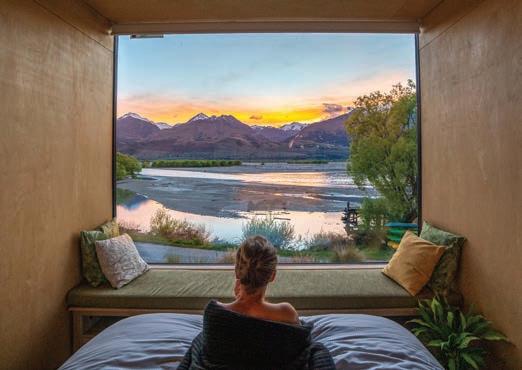
Ekos collaborates with various organisations, from AWWA to Chia Sisters, supporting businesses that make a positive impact. For example, Breen, an Otagobased construction company, successfully diverted construction waste from land lls, leading to emission reductions and cost savings.
To explore our case studies or learn more, visit Ekos or email us at ekos@ekos.co.nz


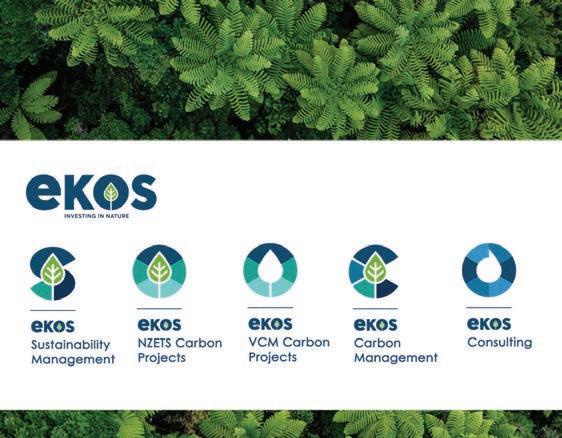
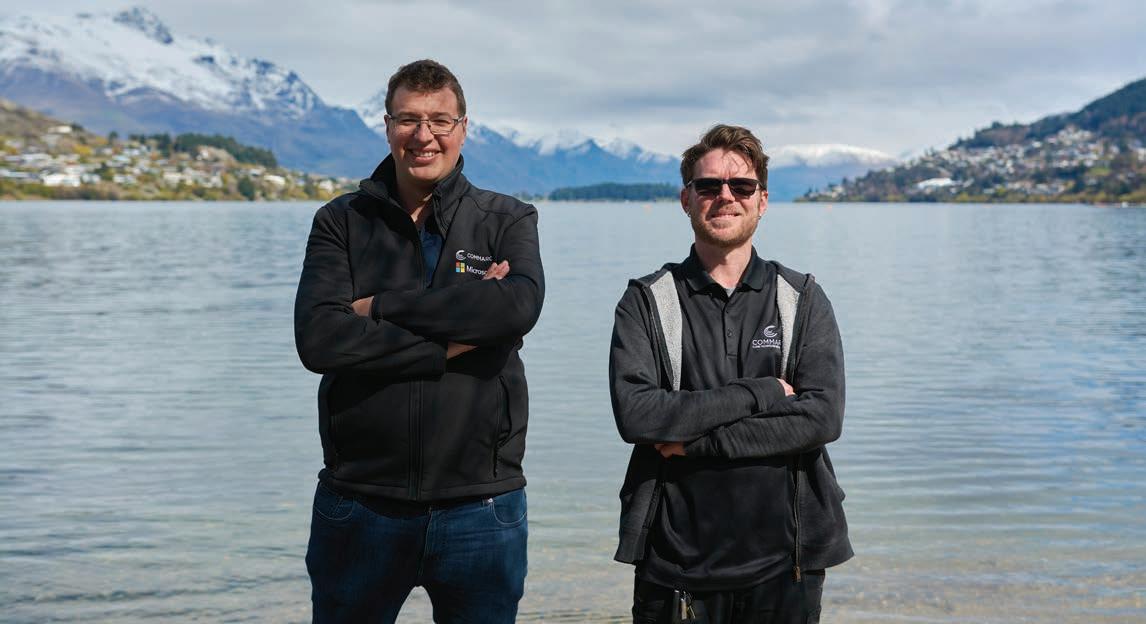
Tech with South Island soul
When it comes to the increasingly complex world of business tech, it is always good to know someone has got your back.
Any chief executive who’s experienced the blue screen of death before an important meeting, or café owner whose system has crashed during a busy lunch service, will know having expert IT help just a phone call away is a life saver.
And, similarly, any business owner not focused on using the wonders of 21st Century technology to improve productivity, e ciency and, ultimately, revenue, is likely now losing some ground to competitors. Running outdated so ware on your own server, sitting in rented o ce space, is likely not going to cut it nowadays.
But even navigating through the choices of di erent companies o ering IT solutions and support can prove di cult. Where do you put your trust?
CommArc is the South Island’s second oldest IT company, with a team of around 50 sta across New Zealand, including two based in Queenstown Lakes. With its headquarters in Christchurch, it helps ll the yawning gap between local one-man-band IT support and dealing direct with the impersonal international tech giants.
“We think it is very important to have a close working relationship with our clients, to know them by name but also have the size and depth to help them at the drop of a hat and to meet their wider needs,”
CommArc CEO Jonn-Paul Lambie says.
“Our clients lean on our expertise and advice, because it is a very dynamic and sometimes confusing space. ere’s so much innovation, something new every ve minutes, which can really help businesses succeed.
“But there are also lots of technical challenges and without the right systems and support, you can click on the wrong email, or put your credentials
in somewhere, and suddenly your data is out there on the internet and you’re having an embarrassing conversation with your bank or your own clients.”
CommArc is an independent, arms-length cloud service provider - essentially an out-sourced IT department providing everything from break- x services, to cyber security, to modern workplace migrations. at sets up businesses to take advantage of the whole ecosystem of cutting edge services you get from Microso , for example, at a relatively low cost. “We’ll come and replace a laptop battery, and at the other end of the scale, we’ll also prepare your business to work in a much-more modern framework, while ensuring your data is safe,” he says.
Lambie says one of the advantages of using CommArc as a managed service provider (MSP) is that a er 31 years in business in the South Island, it knows that one-size does not t all in New Zealand. Clients range from law and accountancy rms, to manufacturing and horticulture.
“Traditional MSPs will quite o en try to t their clients inside a box - they say ‘you must take this service with this outcome, and if you don’t we’re not really interested’.
“While we have services like that, we also realise when it comes to New Zealand, the South Island and places like Queenstown Lakes, the needs of businesses are very varied. You’ve got sole traders and businesses with 2000-head counts of sta . Both important, both very di erent.”
On the whole, the goal is to take the stress away and give clients a positive experience, whether dealing with the “a able geeks” on the support desk, the security specialists, or the big thinkers aimed at optimising the tech for simplicity, growth and success.
And with rise of A.I. on the horizon, and all the opportunities it will o er, the need for this level of
expertise and understanding is only going to increase. “ ere are early adopters and products on the market that are functional and have great business applications, and it is only going to become much more usable and mainstream over the next couple of years.”
Lambie says CommArc continues to grow, merging with Queenstown Tech last year, and last month welcoming Nelson-based BlueBerryIT to the family, with its wealth of expertise in Microso 365 Power Apps and AI.
“Queenstown Lakes is a growth region and we’re a growth business, so we’re looking forward to working with existing and new clients as they prosper.”
support@commarc.co.nz 0800 338 0414 www.commarc.co.nz
Advantages of CommArc
• Expert guidance through experience
• Listening and understanding
• Solid support as well as know-how
• Upli ing not upselling
• What-if creative thinking and e ective solutions
• Transparency in all areas
• Complimentary initial consultation
• Reassuringly deep talent pool
• Competitive pricing, tailored packages, standalone services
• Best-of-breed technology and product innovation
• 24/7 on-call support and well-resourced support desks
• 60mins talk-time instead of the standard 15mins
CommArc’s Queenstown experts, Tom Brash, left, and Matt Shand
RealNZ makes the cut for NZ Tourism Awards

Queenstown-based tourism giant RealNZ has been named as nalists in two categories of the 2024 New Zealand Tourism Awards. It is in the running for the Tourism Environment Award and Tourism Excellence Award (Large Business).
Chief Customer & Sales O cer Scott McNab says the award categories RealNZ are nalists in re ect the company’s longstanding commitment to conservation, while showing visitors to the Deep South some of the best New Zealand has to o er.
“ is is fantastic recognition of our team’s e orts day in and day out – they are champions both in delivering exceptional experiences for our guests, and giving back to the places we are privileged to operate in,” he says.
Meanwhile, former Queenstowner David Kennedy, who now runs Christchurch’s International Antarctic Centre, is a nalist for the Tourism Industry Champion Award.
Kennedy was previously the boss of Destination Queenstown and Ngāi Tahu Tourism, which runs Shotover Jet.
e nals will be held on 6 November in Auckland.

Contact
03 409 2800 | info@qmg.co.nz
Catherine Mercer - Account Manager | 027 777 2785 | cat@qmg.co.nz
Kylee Evans - Account Manager | 021 044 2968 | kylee@qmg.co.nz
David Gibbs - General Manager | 021 514 072 | davidgibbs@qmg.co.nz

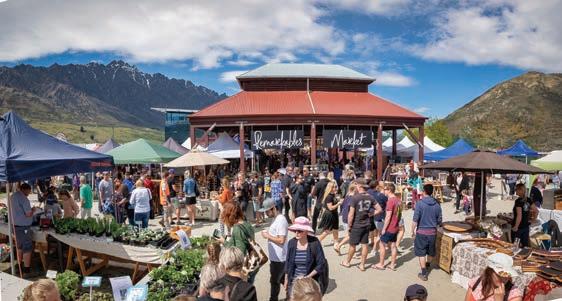
Remarkable push for sustainability
From its beginning in 2010, Remarkables Market has had a sustainability focus and continues work on its ‘Journey Towards Zero Waste’ nding new ways to reduce and remove items from the waste stream
In 2018 a cup stand, with ceramic cups purchased from local charity shops, was built to encourage people to use ceramic cups instead of paper cups. is remains one of the most photographed items at the Market, visitors from all over the world love it!
With only 20% of takeaway cups being diverted from land ll, in 2019 Remarkables Market became the rst market in New Zealand to go Single Use Cup (SUC) Free. anks to a dishwasher and small shed investment, all co ee carts serve drinks in ceramic cups, all juices are served in recycled glass jars. Market sta collect dirties, wash and redistribute clean items back to the stallholders ready for reuse.
Another New Zealand rst in 2023 saw Remarkables Market ban all disposable serveware. anks to an upgraded kitchen being put on site and a grant for a second dishwasher from the QLDC Waste Minimisation Fund, all food items are now served on washable plates with metal cutlery. DISHrupt (an o shoot of Sustainable Queenstown) use the market as a storage facility for their dishes, in return allowing the market use of these on a Saturday.
Changes have been incremental but add up to something substantial and provide pause for sustainability conversations by stallholders, market visitors and Queenstown businesses. e Red Barn is an old airport hangar, much of the grounds have recovered trees, and the playground and pergolas have been provided new homes. Hand dryers have been installed in the market toilets to replace paper towels. Compost bins are utilised by the landscaping team for reuse on the market gardens, and stallholders are encouraged to use recyclable containers and eliminate use of plastic and single use items.
e Red Barn is now becoming a venue outside of the market and potential hirers are encouraged to make their event single serveware free.
Remarkables Market, loved by locals and visitors alike, runs every Saturday 9am2pm from late September through to April. It’s just o Hawthorne Drive in Frankton (follow the signs). With a backdrop of the Remarkables mountain range, grab a co ee, sit down with friends, relax and enjoy the view and the market vibe.
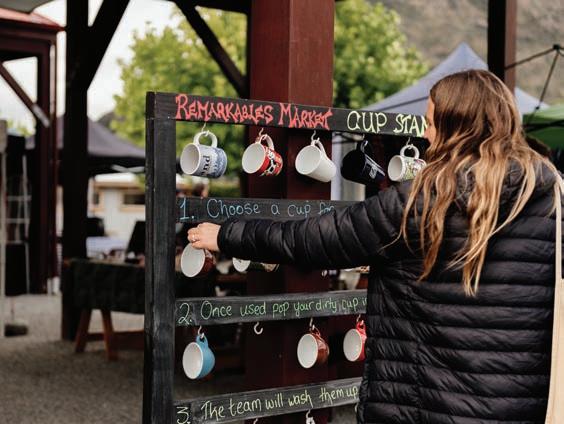
Photo credit: Neville Porter Sponsored
When the going gets tough - resilient businesses
How do you make your business as resilient as possible and prepared for success in a changing world?
at’s the topic of the latest Elevate Series Business Lunch, hosted by Queenstown Business Chamber of Commerce and Queenstown Airport.
BECA’s NZ managing director Andrea Rickard, Air New Zealand’s Chief Sustainably and Corporate A airs O cer Kiri Hanni n, and Auckland Airport’s Chief Strategic Planning O cer Mary-Liz Tuck, are on deck to share their Strategies for a Resilient Business Future. e lunch, MC’d by Queenstown Airport’s Sustainability & Corporate A airs General Manager Sara Irvine, is the last of four Elevate sessions this year.

Andrea Rickard MD at Beca
Making our own business more sustainable is something we directly in uence through our culture and values, and our everyday choices, such as energy consumption and emissions from our vehicle eet. We move to our new global headquarters early next year and this will be a six star green building in Wynyard Quarter in Auckland, with modern end of trip facilities to enable our people to make active travel choices to and from work. e more challenging, and incredibly rewarding, opportunity is actually in how we collaborate with our clients and partners in exploring new technologies and innovative solutions that make progress towards a low carbon future. is is challenging because it requires thinking beyond status quo, bringing di erent people and ideas together in di erent ways, and that can be uncomfortable. Examples are our clients who are part of the ecosystem of transitioning to more sustainable, renewable energy sources, and those who are already grappling with impacts of climate change on vulnerable communities, built infrastructure and the environment. ese are the projects that make a real di erence to our communities, and which our teams at Beca love being part of.
Chamber CEO Sharon Fi eld says they’ve been valuable to Chamber members and attendees.
“We’ve loved working with Queenstown Airport on this and it has been a strong combination of speakers and topics; business connection with the community, how we prepare for the future and be more resilient, what makes for a great customer experience, and sustainability,” she says.
Fi eld says businesses now more than ever need to consider their environmental and corporate social responsibilities as part of their business planning, and it is a learning process for all.
“ is not only bene ts the wider community but also
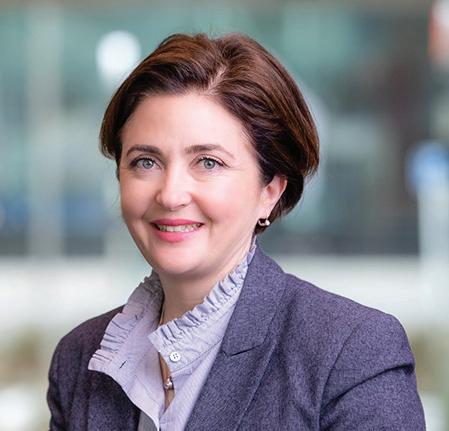
Mary-Liz Tuck, Chief Strategic Planning O cer at Auckland Airport
Auckland Airport has a long history of sustainability, dating right back to 2008 with our rst sustainability policy. is has meant that sustainability is well embedded in our organisation at all levels, and we are seeing great results across our strategic areas, particularly our direct carbon emissions, waste in the terminals and diversity in leadership roles. Our focus is now on working with the industry to decarbonise aviation and an airport’s role is to ensure the right technology is in place at the right time to allow our airline partners to decarbonise. But the technology has a lot of uncertainty, and our challenge is that we don’t know what technology will be needed or when. We need to plan for all possible solutions and be ready to implement them when required. Collaboration across the aviation sector is key to overcoming the challenges that will be faced as aviation seeks to decarbonise.
plays an important role in attracting and retaining employees,” she says.
But, she says, in tough economic times, ensuring the businesses itself is sustainable has to also be a priority.
“You need a viable business, right, in order to think about how you can actually implement sustainable practices. at’s something at the Chamber we’re focused on, how to best support businesses in that space.”
With that in mind, here’s what the three speakers have to say on the challenges of environmental sustainability:

Kiri Hanni n, Chief Sustainability and Corporate A airs O cer at Air New Zealand
Addressing the causes of climate change is one of the most urgent issues facing humanity. e world must decarbonise quickly. Aviation is one of the most di cult sectors to decarbonise. While we know Air New Zealand will require a combination of alternative aviation fuel and next-generation aircra to decarbonise, the scale and technology of those alternates need to dramatically advance over the next decade for the airline to reach net zero by 2050. is isn’t something that can be achieved alone. It can only happen with collaboration across government, fuel suppliers, aircra developers, and airlines. A thriving tourism industry is very important to New Zealand and decarbonising it is vital for its continued success into the future. We are acutely aware of this at Air New Zealand and will continue to do everything we can to reduce our carbon emissions across our operation as quickly as possible.


Supporting sustainable communities
On 27 June, 2019, Queenstown Lakes District Council declared a climate and ecological emergency in response to an intergeneration call to action from our community. is declaration spurred the adoption of the district’s rst Climate Action Plan, to help guide our district toward a more sustainable and environmentally responsible future.
At the heart of Council’s climate e orts is the Climate Reference Group (CRG), an independent, multidisciplinary advisory body composed of Kāi Tahu representatives, community leaders and a range of climate experts. e CRG advise Council on actions related to emissions mitigation, climate change adaptation and biodiversity restoration. eir expertise is invaluable, and the collaboration between Council and the CRG re ects our commitment to communitydriven environmental leadership.
CRG chairperson, Dr Leslie Van Gelder, shared her thoughts on Council’s role in supporting sustainable communities.
“Council can help by creating a joined-up approach that connects the e orts of all partner organisations in the pursuit of improved community and environmental outcomes.
“ is collaborative approach is particularly important for both the spatial planning of the design of our future communities and for the e orts that are being undertaken right now to collaboratively create better conditions for our communities to thrive.”
“ e unlocking of these opportunities can be incredibly complex, so we have to learn to trust each other more, not less, as no one institution holds the single source of knowledge to create this future. e road to trust is through shared commitment, everyone owning their part in the process and a focus on providing the space for creativity to thrive.”
by QLDC Resilience and Climate Action Manager Bill Nicoll
Dr Van Gelder points out that Council can’t do everything itself, but it can be a key enabler and barrier-remover, freeing the way for community and businesses to work toward the goal of a sustainable future.
And there is a clear mandate from our community on the importance of this goal.
According to the latest Quality of Life Survey, 78% of people living in Queenstown Lakes are either concerned (35%) or very concerned (45%) about the impacts of climate change on our district. Respondents expressed a desire for more action from the Council in areas like reducing carbon emissions and enhancing local resilience to climate impacts. is sentiment re ects the growing awareness and concern regarding the e ects of climate change on our communities and on the natural ecosystems of our district.
In response to these community expectations Council has been busy delivering the actions within the Climate and Biodiversity Plan 2022-2025 (CBP). As of September 2024, 23% of the plan’s actions have been completed and 72% are in progress. If you’re interested, we update our ongoing progress on these actions at climateaction.qldc.govt.nz.
A key action that has been ful lled is Council’s commitment to increasing funding for local organisations through the Community Fund 20242027. Over $1.7 million in nancial support was allocated to local organisations through the latest funding round, with a boost of $200,000 coming from the Climate and Biodiversity Plan budget. is funding will help support a diverse range of organisations focused on biodiversity, food resilience, zero waste, and sustainable practices, such as Te Tapu o Tāne, KiwiHarvest, WAI Wānaka, and the Whakatipu Reforestation Trust, all of whom play pivotal roles in fostering sustainability in the region.
Council has also recently launched its dra Welcoming Plan which is aimed at fostering inclusivity and building connections among residents. As part of Welcoming Week, a series of events was held in September to highlight the importance of creating welcoming and inclusive communities that are also sustainable and climate conscious.
Another key area of focus for Council is on supporting community preparedness for the severe weather events associated with climate change. Council partners with Emergency Management Otago to support a growing network of Community Response Groups across the district. ese groups are formed by passionate local volunteers who are committed to ensuring that their communities are ready and prepared for emergency events. Climate change will likely increase the frequency of severe weather events so we’ve committed over $40,000 in funding equipment to ensure these groups can activate Community Emergency Hubs when needed.
Council is also focussed on the potential impact that a changing climate will have on our local food system. We’ve partnered with WAO Wānaka on the Queenstown Lakes Food Resilience Project, which seeks to improve our local food system’s resilience to disruptive shocks and sustained stresses. is important project aims to address key challenges associated with climate change and food security by encouraging community involvement in creating a robust, self-sustaining food network.
As Council moves forward with its climate, biodiversity and sustainability e orts, the focus remains clear: fostering collaboration, supporting innovative solutions, and building a resilient, sustainable, and inclusive community that can thrive for generations to come.
QLDC’s independent Climate Reference Group: (l-r) Dr Leslie Van Gelder (CRG Chairperson), Dr Lyn Carter, Dr Jim Salinger, Amanda Robinson (emeritus), Sydney Telfer, Tony Pfeiffer, Dr Chris Cameron, Alec Tang, Victoria Crockford, Dr Barrie Wills, Eleanor Trueman and Evelyn Cook (not pictured)

